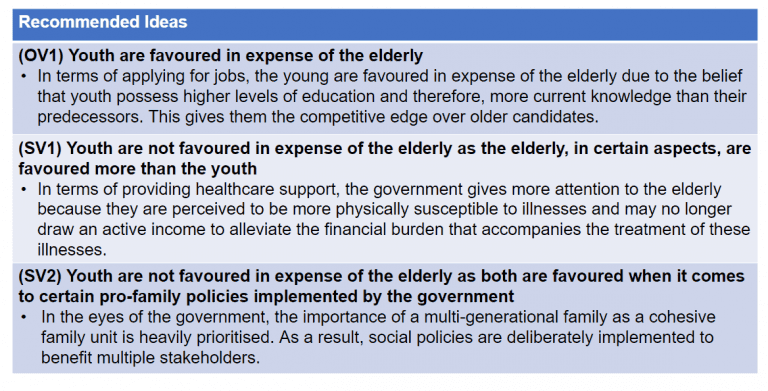Question Analysis:
Possible Ideas:
Legend:
SV = Supporting Viewpoint
OV = Opposing Viewpoint

Sample Paragraphs:
(OV1)
In terms of applying for jobs, the young are favoured in expense of the elderly by certain employers. This is due to the general belief that youth possess higher levels of education and therefore, have more current knowledge than their predecessors. Thus, this gives them the competitive edge over older candidates. In comparison, older candidates tend to have humbler educational qualifications and their experience can be increasingly outdated. To exemplify my point, the Tripartite Alliance for Fair and Progressive Employment Practices (TAFEP), recently shortened to be that of Tripartite Alliance (TAL), stated in a 2013 report that more 60 per cent of organisations believe that the young have the edge in sales, flexibility and reduced salary costs. Such a statistic demonstrates that employers are aware of the advantages of hiring younger individuals as they are more well-informed about current consumers’ needs and trends. Hiring them also places less strain on a company’s finances due to lower labour costs. Possessing higher levels of academic qualification and being more acquainted with the advantages of modern technology, youth’s knowledge far exceeds the elderly in this respect and therefore, this results in greater preference by organisations when considering the hiring of new employees. If it were true that the young are not favoured in the field of employment, there would not be such a disproportionate preference for the young as reflected by local employers’ beliefs in Singapore. Hence, when having academic qualifications and updated knowledge as part of key hiring indicators, I argue that the young are favoured more than the elderly.
(SV1)
On the other hand, it is important to not disregard the fact that in other aspects of society, both age groups are favoured. In the eyes of the government, having a multi-generational family as a cohesive family unit is heavily prioritised. As a result, social policies are deliberately implemented to benefit multiple stakeholders, both the young and the old. This also ensures that family members of different generations can perform their respective roles within the family more effectively; the older generation serving the role of guardians and mentors while the younger generation assuming the role of income earners. To further illustrate my point, housing grants such as Housing Development Board (HDB)’s Proximity Housing Grant (PHG) have been introduced to help families when purchasing a resale flat to live with or close to each other for mutual care and support. Under the PHG, families purchasing a resale flat within four kilometres of their parents’ or child’s HDB flat or private property they live in will receive $20 000 worth of housing grant. Since 2018, singles can receive $10 000 worth of housing grant if they purchase a resale flat near their parents’ homes. Such initiatives demonstrate that the government recognises the importance of a strong family unit, with family members, both young and old, living near each other in order to foster stronger family bonds whilst simultaneously fulfilling their respective roles of caregivers and breadwinners. Should the young be favoured in expense of the elderly, such pro-family policies would not have been implemented where both generations benefit. Thus, given the Singapore government’s support for housing and family, I argue that both are favoured.
Additional Note:
With reference to OV1, it is possible to bring in examples (in this case, statistics) that are not the most updated - as long as they are used to support the main argument and that the events mentioned are applicable within the context of the question (in this case, modern Singapore).
Links for Reference: